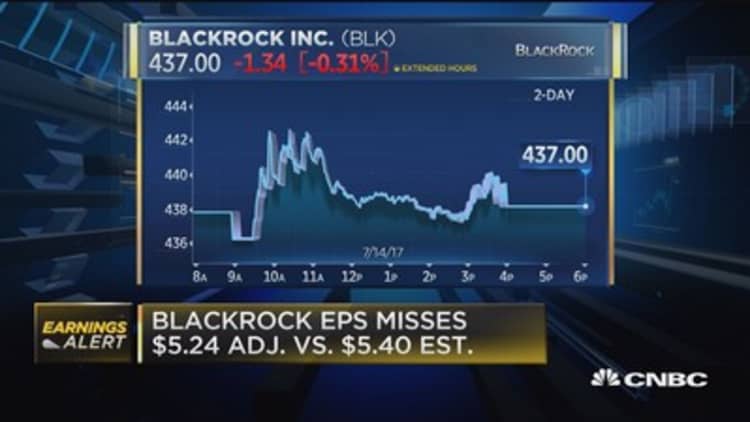
As the head of the world's largest asset management firm sees things, ETFs will be playing an ever-increasing role in investor portfolios in ways that the financial world never saw coming.
Whether it's getting a toehold in mortgages, developing new hedging strategies or simply trying to generate outperformance, BlackRock CEO Larry Fink believes growth of the funds could be in its early stages.
That's quite a statement to make considering that total U.S. ETF assets just breached $3 trillion, or about triple where they were six years ago.
"We're seeing more utilization across the board in more products," Fink told analysts on a conference call after the firm reported second-quarter earnings Monday morning. "We have much more opportunities for ETFs to grow not just in equities but in fixed income. I believe this is just the beginning."
BlackRock is the biggest player in the burgeoning ETF industry, with assets in its iShares family crossing $1.5 trillion in the past quarter. The firm manages nearly $5.7 trillion for clients.
Officials emphasized the iShares growth in a quarter that otherwise disappointed. BlackRock posted earnings of $5.24 a share, missing analyst estimates of $5.40, sending its shares down more than 3 percent in intraday trading.
Indeed, the ETF story is compelling: Back in 2010, the industry boasted just $992 million in assets and was still a relatively unknown frontier on the investing landscape. Now, though, ETFs have evolved into places few had suspected.
Among those that Fink cited were mortgage-backed securities, the replacement of derivatives and options in hedging strategies, and, perhaps the most compelling, the use of passive-focused ETFs in active strategies to try to generate outperformance when compared with benchmarks.
"We believe the environment for ETFs is continuing to evolve," he said. "We believe it's continuing to grow, and much of it also has to do with ecosystem innovation."
Even more growth ahead
There have been a number of wide-eyed calls for industry growth — PwC last year forecast that ETF assets would nearly triple in the next five years alone — so Fink's optimism is hardly isolated.
The big story then is more likely to be the evolution in usage. More investors are using ETFs to blend strategies, combining the opportunity seeking of active management with the diversity of passive investing. ETFs allow investors to be exposed to a sector like energy without having to take on the risk of getting blown out should an individual stock tank.
"We are seeing more investors use ETFs to express active bets in a certain way," said Alex Bryan, director of passive strategies research at Morningstar. "A lot of times managers are trying either to hedge their exposure to certain risk or to express a macro bet on certain things."
Examples would be as simple as buying the iShares iBoxx $ High Yield Corporate Bond fund to get exposure to junk bonds by not having to buy individual company issuance, or as complicated as moving quickly in and out of other funds as a way to short-term trade sectors ahead of earnings.
Some of the more exotic products may be out of the realm of what retail investors do, but institutional investors — pensions, insurance companies, endowments — are finding the funds valuable to execute their strategies.
"The industry's growing because there are new adopters coming on line every day," said Matt Collins, director of U.S. product operations at ETF Securities, which focuses on commodity funds.
"Particularly for hedge funds, the tactical side of the institutional world is starting to use ETFs more and more to express pretty minute theories or investment themes," he added. "It could be corporate high yield, it could be subsectors like biotech, it could be momentum ETFs that only target stocks with momentum in them. They're starting to use ETFs, where just a few years ago maybe they were using futures or individual stocks."
For BlackRock, the trend has been particularly profitable. The firm pulled in a record $73.8 billion in long-term net inflows to iShares products.
"There's newer and newer uses for ETFs every single day," said BlackRock President Rob Kapito. "It's not only stealing market share, it's creating market share, which is the great opportunity for all of us."
WATCH: A banner first half for ETFs



